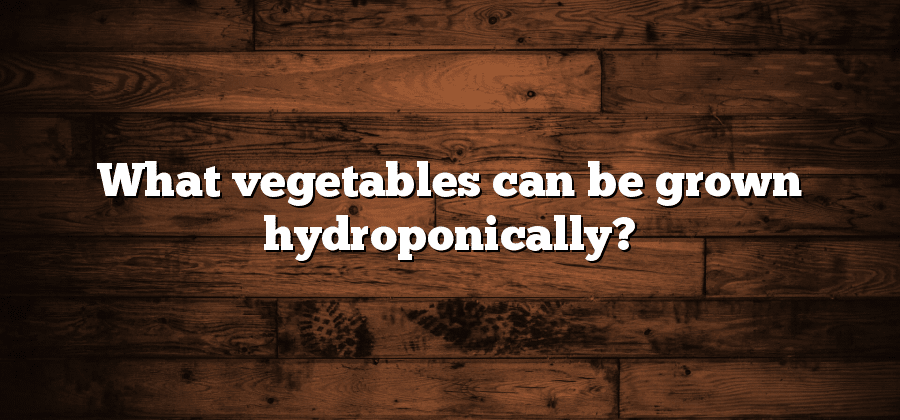Benefits of Hydroponic Vegetable Farming
Hydroponic vegetable farming offers numerous benefits in terms of both productivity and sustainability. One of the key advantages is the ability to grow vegetables in a controlled environment, which eliminates the reliance on soil quality and external weather conditions. This means that farmers can cultivate crops throughout the year, regardless of the season. Additionally, hydroponic farming requires significantly less water compared to conventional soil-based agriculture, making it a more environmentally friendly option.
Another advantage of hydroponic vegetable farming is the efficient use of space. Since plants are grown in nutrient-rich water solutions, there is no need for large fields or extensive land areas. This makes hydroponics particularly suitable for urban areas or regions with limited space for agriculture. Moreover, the controlled environment allows for optimal plant growth and minimizes the risk of disease and pest infestations, resulting in higher crop yields and quality. Overall, hydroponic vegetable farming offers a sustainable, space-saving, and highly productive alternative to traditional farming methods.
Suitable Hydroponic Vegetables
Hydroponic vegetable farming offers a wide range of possibilities when it comes to the types of vegetables that can be grown. Leafy greens such as lettuce, spinach, and kale are particularly well-suited for hydroponic cultivation as they have shallow root systems and can thrive in nutrient-dense solutions. These vegetables can be grown year-round, ensuring a constant supply of fresh, healthy greens. Additionally, herbs like basil and cilantro can also be grown hydroponically, providing intense flavors and aromas for culinary use.
Another category of vegetables that can be successfully grown hydroponically is the vine crops, including tomatoes, cucumbers, and peppers. These vegetables require a bit more space to grow, but with the right hydroponic system, they can flourish. Growing vine crops hydroponically can result in higher yields and earlier harvests compared to traditional soil-based methods. Moreover, by eliminating the need for soil, vine crops grown hydroponically are less susceptible to soil-borne diseases and pests, leading to healthier plants and increased productivity.
Ideal Hydroponic Growing Conditions
To achieve optimal growth, hydroponic vegetables require specific growing conditions that closely mimic their natural habitat. Firstly, temperature control is crucial. Most hydroponic vegetables thrive in temperatures between 65°F and 75°F (18°C and 24°C), as this range encourages healthy root development and supports efficient nutrient absorption. Additionally, maintaining a stable pH level within the recommended range of 5.5 to 6.5 is paramount. A balanced pH level ensures that plants can absorb the necessary nutrients, promoting robust growth and minimizing nutrient deficiencies.
Furthermore, adequate lighting plays a significant role in hydroponic vegetable farming. Whether using natural sunlight or artificial grow lights, providing the correct lighting intensity for the specific plant species is vital. In general, vegetables require around 12 to 16 hours of light per day. LED grow lights are a popular choice for hydroponic growers, as they are energy-efficient, emit less heat, and can be tailored to deliver the ideal spectrum for plant growth. Investing in a reliable light meter and regularly monitoring light levels will ensure that plants receive the appropriate amount of illumination for optimal photosynthesis.
Choosing the Right Hydroponic System
When it comes to hydroponic vegetable farming, choosing the right hydroponic system is crucial for success. With the wide range of options available, it can be overwhelming to decide which system is most suitable for your specific needs. However, by considering a few key factors, you can make an informed decision.
Firstly, it is essential to assess the space available for your hydroponic setup. Different systems require varying amounts of space, so it is important to choose one that fits within your allotted area. Additionally, consider the scalability of the system – if you plan to expand your farming operation in the future, opt for a system that allows for easy expansion.
Another vital aspect to consider is the complexity of the system. Some hydroponic systems are more beginner-friendly and require less technical knowledge, while others may be more advanced and require a higher level of expertise. Assess your own skill level and the amount of time you can dedicate to maintaining the system to ensure a seamless integration into your farming routine.
Nutrient Requirements for Hydroponic Vegetables
Hydroponic vegetable farming relies on a carefully balanced nutrient solution to ensure the plants receive all the essential elements they need to thrive. While traditional soil-based farming may rely on the natural nutrients present in the soil, hydroponics requires a more controlled and precise approach to nutrient management.
One important aspect of nutrient requirements for hydroponic vegetables is understanding the specific needs of each plant. Different vegetables have varying nutrient requirements, and it is crucial to provide them with the right balance of macronutrients and micronutrients. Macronutrients such as nitrogen, phosphorus, and potassium are needed in larger quantities, while micronutrients like iron, calcium, and zinc are needed in smaller amounts. Achieving the right balance of these nutrients in the hydroponic solution is key to promoting healthy growth and maximizing yields.






